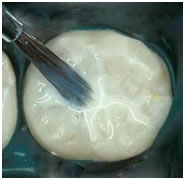Sealants

“Sealant” refers to a clear or shaded plastic material placed in the pits and grooves of children’s teeth to prevent decay. The pediatric dentist applies this invisible protector by drying and conditioning the teeth, painting on the sealant and then allowing it to harden.
The AAPD recommends sealants as an effective method for cavity prevention, especially for those children with a history of tooth decay. In addition, sealants are one of the most cost-effective means of preventing cavities – they cost less than half of what one filling costs!
1. What are sealants?
Sealants protect the grooved and pitted surfaces of the teeth, especially the chewing surfaces of back teeth where most cavities in children are found. Made of clear or shaded plastic, sealants are applied to the teeth to help keep them cavity-free.
2. How do sealants work?
Even if your child brushes and flosses carefully, it is difficult—sometimes impossible—to clean the tiny grooves and pits on certain teeth. Food and bacteria build up in these crevices, placing your child in danger of tooth decay. Sealants “seal out” food and plaque, thus reducing the risk of decay.
3. How long do sealants last?
Research shows that sealants can last for many years if properly cared for. Therefore, your child will be protected throughout the most cavity-prone years. If your child has good oral hygiene and avoids biting hard objects, sealants will last longer. Your pediatric dentist will check the sealants during routine dental visits and recommend re-application or repair when necessary.
4. What is the treatment like?
The application of a sealant is quick and comfortable. It takes only one visit. The tooth is first cleaned. It is then conditioned and dried. The sealant is then flowed onto the grooves of the tooth and allowed to harden or hardened with a special light. Your child will be able to eat right after the appointment.

Sealant application
5. How much does it cost?
The treatment is very affordable, especially in view of the valuable decay protection it offers your child. Most dental insurance companies cover sealants. Some companies, however, have age and specific tooth limitations. Check with your benefits provider about your child’s coverage and talk to your pediatric dentist about the exact cost of sealants for your child.
6. Which teeth should be sealed?
The natural flow of saliva usually keeps the smooth surfaces of teeth clean but does not wash out the grooves and fissures. So the teeth most at risk of decay—and therefore, most in need of sealants— are the six-year and twelve-year molars. Many times the permanent premolars and primary molars will also benefit from sealant coverage. Any tooth, however, with grooves or pits may benefit from the protection of sealants. Talk to your pediatric dentist, as each child’s situation is unique.
7. If my child has sealants, are brushing and flossing still important?
Absolutely! Sealants are only one step in the plan to keep your child cavity-free for a lifetime. Brushing, flossing, balanced nutrition, limited snacking, and regular dental visits are still essential to a bright, healthy smile.
Sources
http://www.aapd.org/publications/brochures/sealants.asp
http://www.aapd.org/media/Policies_Guidelines/G_Restorative.pdf 2011-2012
Sanders BJ, Feigal RJ, Avery DR. Pit and fissure sealants and preventive resin restorations. In: Dean JA, Avery DR, McDonald RE. Dentistry for the child and adolescent. St. Louis, Mosby Elsevier, 9th ed., 2011, p:313-321.





